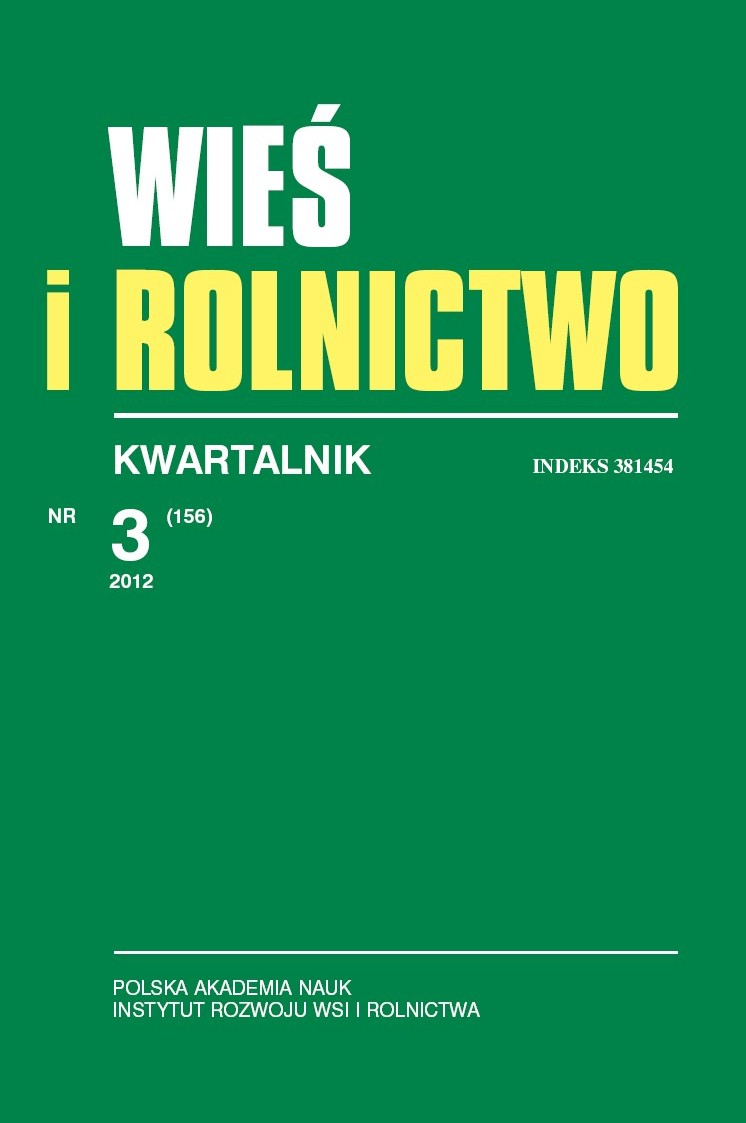What effect does national regulation have on LEADER programming in the EU-27?
DOI:
https://doi.org/10.53098/wir.2012.3.156/01Keywords:
public action, LEADER programme, Europe, model transfer, normsAbstract
The LEADER programme, introduced in 1991 and integrated into the European policy for rural development, is a figurehead of local action in Europe. Based on local partnerships, gathering entrepreneurs, elected representatives and associates on a voluntary basis, it will exemplify the principles of co-operation and subsidiarity and so contribute to the strengthening of local democracy. Researchers and development practitioners agree on its innovative character and its potential of “portability” in the fact that it offers to each State a certain freedom in its application. Each country of the European Union can decline the objectives according to the priorities that it settles and has a wide latitude on how it places financial means and the modalities of its implementation. In this article, we focus on the modalities of the LEADER programme transfer (2007-2013) to all 27 EU member states. In this article, we focus on the territorial effects of terms of the transfer of the LEADER programme (2007-2013) to all 27 Member States of the EU.References
Arhenz H., 2004: Agricultural Policy and Rural Development: Theoretical and Empirical Aspects. In: The Role of Agriculture in Central and Eastern European Rural Development: Engine of Change or Social Buffer? Ed. M. Petrick, P. Weingarten. ”Studies on the Agricultural and Food Sector in Central & Eastern Europe” 25, IAMO: 340–355.
Bulmer S., Dolowitz D., Humphereys P., Padgett S., 2007: Policy Transfer in European Union Governance: Regulating the Utilities. Routledge, Abingdon. DOI: https://doi.org/10.4324/9780203964743
Callahan R., 2007: Governance: The collision of politics and cooperation. ”Public Administration Review” 67 (2): 290–301. DOI: https://doi.org/10.1111/j.1540-6210.2007.00714.x
Chevalier P., 2012: Le transfert du modele européen LEADER: entre diffusion des normes et durcissement réglementaire. ”Revue d’Etudes Comparatives Est-Ouest” 3. Action publique et développement territorial en Europe centrale. DOI: https://doi.org/10.3917/receo.433.0017
Chevalier P., Maurel M.-C., 2010: LEADER w krajach Europy Środkowej. Mechanizmy transferu modelu rozwoju lokalnego [Policy Transfer of the Local Development Model. The Leader Program Implementation in Central European countries]. „Wieś i Rolnictwo” 4: 26–41. DOI: https://doi.org/10.53098/wir.2010.4.149/02
Chevalier P., Maurel M.-C., 2012: L’expérimentation de l’approche LEADER en Hongrie et en République tcheque: deux logiques politiques différentes. ”Revue d’Etudes Comparatives Est-Ouest” 3. Action publique et développement territorial en Europe centrale. DOI: https://doi.org/10.3917/receo.433.0091
Deberre J.-C. 2007: Décentralisation et développement local. ”Afrique contemporaine” 221: 45–54. DOI: https://doi.org/10.3917/afco.221.0045
Denters B., Rose L.E., 2005: Comparing Local Governance. Trends and Developments. Palgrave Macmillan, Houndmills, Basingstoke, Hampshire. DOI: https://doi.org/10.1007/978-0-230-21242-8
Dore G., 2011: Le programme européen LEADER a 20 ans: Bilan et perspectives a partir du cas français. Communication aux 5emes journées de Recherches en Sciences Sociales, SFER-INRA-CIRAD, Agrosup Dijon.
Europeenee Commission, 2011: Cinquieme rapport sur la cohésion économique, sociale et territoriale. OPUE.
Gorton M., Hubbard C., Hubbard L., 2009: The folly of European Union policy transfer: why the Common Agricultural Policy (CAP) does not fit Central and Eastern Europe. ”Regional Studies” 43: 1305–1317. DOI: https://doi.org/10.1080/00343400802508802
Halamska M., 2005: Rozwój wiejski w Portugalii w latach 1986–2000. Wzór czy przestroga dla Polski? [Le développement rural au Portugal dans les années 1986–2000. Un modele ou un avertissement pour la Pologne?]. IRWIR PAN, Varsovie.
Halamska M., Maurel M.-C., (ed.), 2010: Les acteurs locaux a l’épreuve du modele européen LEADER. France-Hongrie-Pologne. CEFRES/IRWIR PAN, Prague.
Jouen M., 2011: La politique de cohésion. La Documentation Française.
Kukorelli Szorenyine I., 2005: The Appearance and Role of Micro-Regional Co-operations in the Hungarian Spatial Development. ”Geografický Easopis” 57, 3: 229–246.
Lacquement G., 2008: Du développement local dans les nouveaux Länder allemands: acteurs et territoires des programmes d’initiative communautaire LEADER+. ”Revue d’Etudes Comparatives Est-Ouest” 39, 4: 81–112. DOI: https://doi.org/10.3406/receo.2008.1926
Lostak M., Hudeckova H., 2010: Preliminary impacts of the LEADER+ approach in the Czech Republic [Predbezné dopady prístupu LEADER+ v Ceské Republice]. ”Agricultural Economics” 1/56: 249–265. DOI: https://doi.org/10.17221/27/2010-AGRICECON
M.A.P.A., 2009: Plan Estratégico Nacional de Desarrollo Rural, 2007–2013. Madrid.
Maurel M.-C., 2008: L’action publique „par le bas”: l’approche LEADER en Europe centrale. ”Revue d'Etudes Comparatives Est/Ouest” 39: 59. DOI: https://doi.org/10.4074/S0338059908004038
Maurel M.-C., Halamska M., 2006: Démocratie et gouvernement local en Pologne. CNRS editions, Paris.
Maurel M.-C., Pola P., 2010: L’émergence du développement local: le cas de Bóly en Transdanubie méridionale. In: M. Halamska, M.-C. Maurel (dir.) Les acteurs locaux a l'épreuve du modele européen LEADER: France-Hongrie-Pologne. CEFRES/IRWIR PAN, Prague.
Palne-Kovacs I., 2011: Local governance in Hungary-the balance of the Last 20 Years. Discussion papers n°83. Centre for Regional Studies of Hungarian Academy of Sciences, Pécs.
Plesiat M., Martu P., Actors and partnerships in the LAGs: a new civic space? A Czech case study. Paper to the Regional studies association conference, Pécs, 24–26th, May.
Pola P., Kovacs I., 2010: Some experiences of the Hungarian LEADER program. Regional Studies Association, Annual International Conference, Pécs (Hongrie), 24–26 May.
Ramniceanu I., Ackrill R., 2007: EU rural development policy in the new member states: promoting multifunctionnality? ”Journal of Rural Studies” 23: 416–429. DOI: https://doi.org/10.1016/j.jrurstud.2006.10.003
Ray C., 2000: The EU LEADER Programme: Rural Development Laboratory. ”Sociologia Ruralis” 40, 2: 163–172. DOI: https://doi.org/10.1111/1467-9523.00138
Saurugger S., Surel Y., 2006: L’européanisation comme processus de transfert de politique publique. ”Revue internationale de politique comparée” 13, 2: 179–211. DOI: https://doi.org/10.3917/ripc.132.0179
Smith A., 1995: L’Europe politique au miroir du local. Les fonds structurels et les zones rurales en France, en Espagne et au Royaume-Uni. L’Harmattan.
Spieser C., 2008: Les fonds structurels européens: quels outils pour faire face aux restructurations? ”Revue Internationale de Droit Economique” 22: 2. DOI: https://doi.org/10.3917/ride.222.0213
Downloads
Article file downloads
Pages
How to Cite
Issue
Section
License
Copyright (c) 2012 Wieś i Rolnictwo

This work is licensed under a Creative Commons Attribution 4.0 International License.










